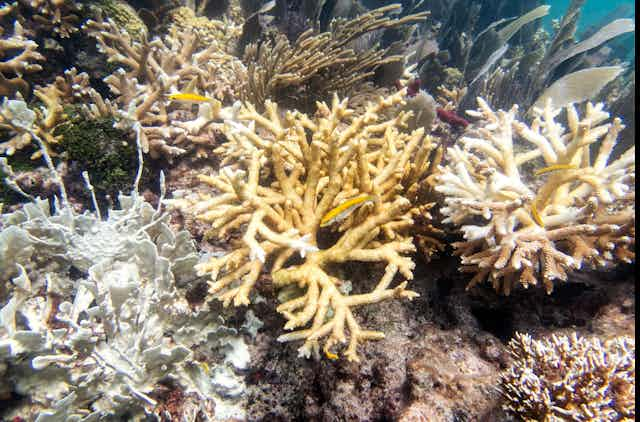Coral reefs are vital ecosystems for people and coastal communities. They provide food and livelihoods and protect coastlines from storms, contribute to local economies and preserve cultural heritage.
However, warming ocean temperatures as a result of human-made climate change present considerable risks to the reefs. The recent rise in coral bleaching all over the world is the most visible impact.
But what is coral bleaching? Coral bleaching is a phenomenon that occurs when the white skeleton of the corals becomes visible after the microalgae that live inside their translucent tissues are expelled.
Even though coral reefs can recover from bleaching events, the process, much like the regrowth of a forest following a windstorm or wildfire, requires a considerable amount of time. And, as our research has shown, an appreciation of the role of cloud cover.
Relief in the clouds
Although coral bleaching is generally linked only to ocean temperatures, the process itself is a product of the interaction between high temperatures and sunlight levels in a given area.
If the temperatures are high enough, the coral and microalgae become more light-sensitive. When combined with excessive sunlight, this sensitivity harms the microalgae which, in turn, results in the production of chemical compounds called reactive oxygen species. These compounds are harmful to many species and in the case of reefs cause the coral to expel its microalgae.

In the same way that clouds protect us from harmful exposure to UV rays, clouds also provide a protective barrier for the world’s coral reefs. Field studies of coral bleaching events in French Polynesia and in the Republic of Kiribati found that periods of cloudiness may have reduced the bleaching severity and extent.
Climate change is projected to kill off most of the world’s coral reefs, even in scenarios with only 1.5 C of global warming. Yet, to date, most analysis has only considered the effect of temperature. Could incorporating clouds change the forecast?
Considering cloudiness
In order to understand how cloudiness might influence the response of coral reefs to climate change, our recent study used a global historical database containing almost 38,000 coral bleaching reports to train an algorithm that estimates bleaching severity based on incoming light and temperature stress.
Our algorithm was then applied to four different future climate scenarios on the world’s coral reefs to assess if and when bleaching conditions would become too frequent for reefs to recover. The results indicate that under a low emissions scenario, increased cloudiness would indeed have an effect on the coral bleaching conditions. This means that corals would have more time to recover from the impacts of rising temperatures and improve their resilience.
Read more: Coral reefs: How climate change threatens the hidden diversity of marine ecosystems
However, even under a low carbon emission scenario, this extra time will not be enough to prevent more than 70 per cent of global reefs experiencing frequent bleaching conditions with not enough time in between to fully recover.
This highlights the severity of the coral bleaching crisis caused by thermal stress and the limitations of relying solely on cloudiness as a protective mechanism. Simply put, while clouds can offer some relief to corals, they cannot mitigate the long-term consequences of climate change when the sea surface temperature becomes too high.
Clear implications
Cloud cover may offer temporary relief to coral reefs by delaying the adverse environmental conditions responsible for coral bleaching. However, that seems to be partially true only in the lowest emission scenario which would be possible only if we dramatically cut greenhouse gas emissions.
Without doing that, dangerously frequent bleaching conditions are unavoidable and reefs will continue to be threatened even if we cut down emissions now. Moreover, we also need to get serious about habitat and biodiversity protection to increase resilience.
Only by doing this could coral reefs stand a chance at surviving the increasing pressures of climate change. Any other approach has its head in the clouds.

